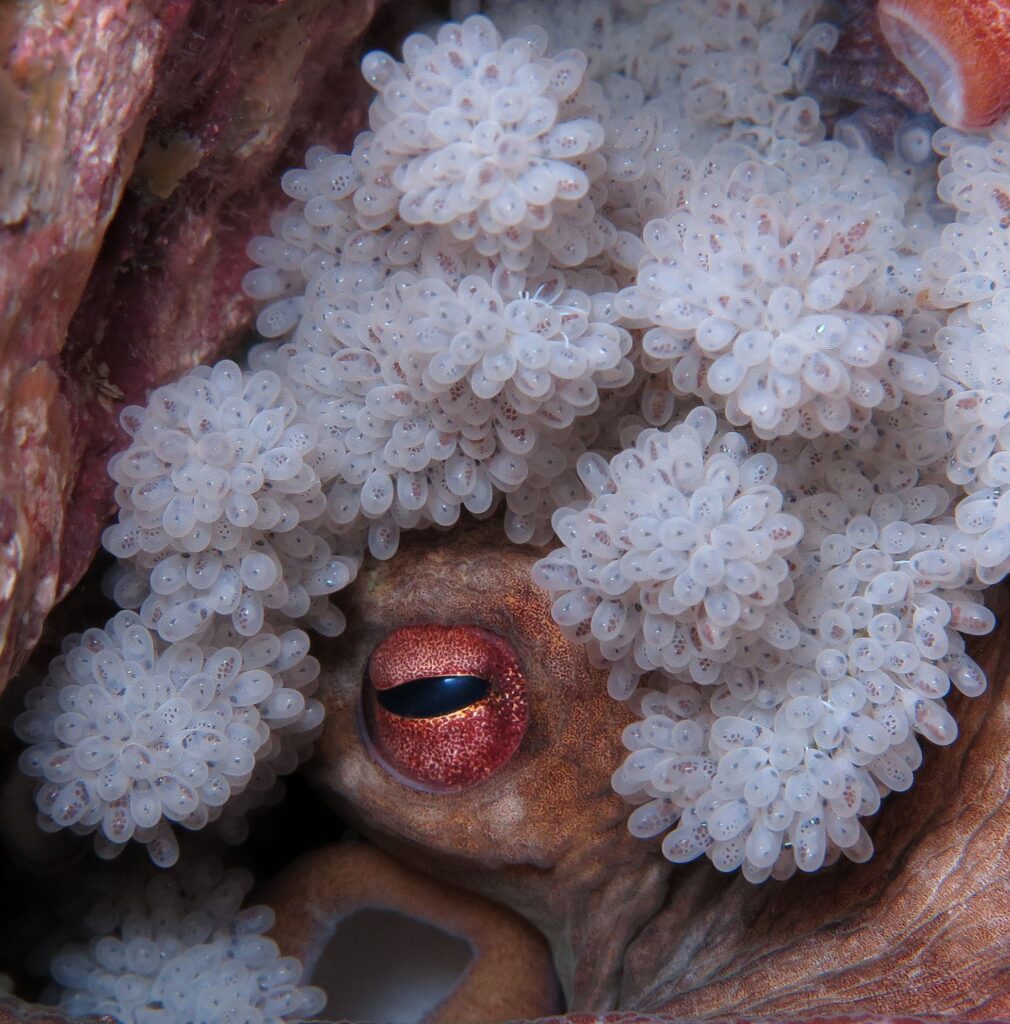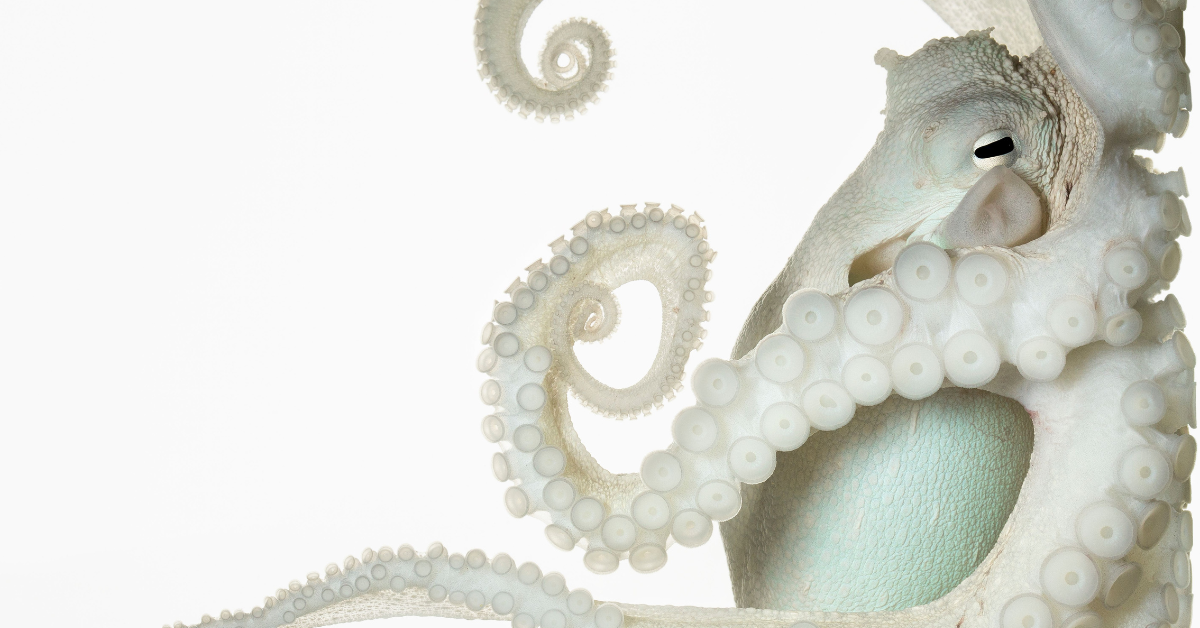By Nicole Rivard
Watching a fist-sized coconut octopus use half of a clamshell as a shield to protect itself from a small but highly aggressive mantis shrimp—armed with the fastest, deadliest punch in the animal world—I found myself grinning from ear to ear.
This was after the octopus first used the entire shell as a safe house to protect itself from a large shoal of hungry mullet.
This octopus had brawn and brains. I was filled with wonder to say the least.
That’s the whole point of the National Geographic docuseries and companion book Secrets of the Octopus, which were released in the spring. The book is written by The New York Times bestselling author and naturalist Sy Montgomery. Warren Carlyle, the founder of Octonation, an online octopus fan club and educational non-profit organization, is a contributor.
When I share my reaction to the coconut octopus with them, Montgomery said: “It’s such a riot because octopuses became octopuses when they gave up having shells. So, to go back to the shell to get the protection that they need—while keeping all of benefits of not having a shell—they are geniuses.”
I didn’t know the ancestors of octopuses once sported hard shells. But even scientists didn’t know much about octopuses—who’ve been around for 328 million years—until recently.
The current explosion in octopus science is what Montgomery brings to life in Secrets of the Octopus. She explores how they change their color hundreds of times an hour and transform the shape of their bodies to mimic their deadliest enemies; their ability to solve complex problems, strategize and even plan for the future; and their unexpected social lives.
Carlyle shared another secret of the coconut octopus not in the book—while most female octopuses lay strands of white eggs the size of rice-grains, which they cement with a secretion from a gland in their head to the roofs of their dens—the coconut octopus will sometimes use shells or a coconut half to support her eggs.
“Coconut octopuses are transient, so it’s almost like she’s using a high-end stroller that she can travel with,” he said with a laugh. “She will pick up the shell or the coconut with her eggs in it with six of her arms, and she will ‘walk’ on the tips of her other two arms across the ocean floor. It’s called stilt walking.”
“I just love that,” Montgomery remarked.
Really there’s nothing not to love once you see octopuses through these authors’ eyes—they communicate with other species, have individual personalities, express emotion and they might even dream.
It’s even more remarkable when you realize that everything octopuses have learned about the world, they’ve taught themselves, because they are born into the world as orphans.

After egg laying, an octo-mom won’t even leave the eggs to hunt for food. In fact, the part of the octopus’s brain that governs her urge to eat shuts down. As a result, the octo-mom slowly starves and dies around the same time her babies hatch.
Calling all octopus lovers
Montgomery published her first book, Soul of an Octopus, in 2015. Carlyle, who has a fashion marketing background, was so taken with it he vowed to continue telling the story of this incredible creature—one he’s adored since childhood—and to foster love for the ocean through the lens of the octopus.
He launched Octonation (octonation.com) in 2015. He now has seven PhD octopus experts involved and one million members.
“Octopuses never had a good PR agent,” said Carlyle, pointing out that early naturalists and philosophers like Aristotle considered the curious nature of octopuses and deemed them to be simple-minded. And centuries of Western literature portrayed octopuses as oceangoing demons.
“I decided I was done with people making up stories about how this creature is. This creature is iconic,” said Carlyle.
Encounters of the octopus kind
One of the best things about Secrets of the Octopus is you feel like you are encountering octopuses in the wild right along with the scientists and filmmakers.
“What struck me, and all our team… is when the octopus decides you’re ok, it lets you into its world,” said filmmaker Adam Geiger. “Most wild animals might ignore you or leave. But the octopus allows this huge, possibly dangerous animal, the diver, to get close and will even reach out to you. It’s absolutely remarkable. They are incredibly engaging.”
When an octopus extends its arms to explore the divers, they change color. There’s compelling evidence that such changes in octopus skin resemble emotional expression, the way a human might frown, smile or blush.
Even if you never get to encounter octopuses in the wild, Montgomery believes it is very meaningful to read a book or see a documentary that leaves you feeling mesmerized by their otherness rather than be offput by it.
“Octopuses demonstratively think, feel and know and do so using senses that we don’t have,” Montgomery said. “The fact that you can be ‘friends’ with someone who can taste with their skin, change color and shape, pour their boneless body through a tiny opening, shoot ink, use venom, who has a beak in its armpits, three hearts, and a brain wrapped around its throat…I mean, WOW.
“I think it just makes the world a bigger place and makes us more at home in it.”
World-first octopus farming ban
For Friends of Animals, the fact that octopuses are having a moment means that it is less socially acceptable for them to be on a menu, and that rings all our bells. We support any efforts stop the mass production of octopuses before it begins.
While there are currently no large-scale octopus farms in the world, several companies and producers are looking to change that.
Octopus farming has been outlawed in Washington state thanks to a first-of-its-kind bill signed into law on March 13.
“Octopus farming hurts our environment and causes suffering for octopuses, and it is well past time to prohibit this callous practice,” Representative Strom Peterson, who sponsored the bill, said in a statement.
California and Hawaii are trying to pass similar legislation.
“Octopuses should be able to shout and swim about the coral that lies beneath the waves. They shouldn’t be confined to pens. There should be no one there to tell them what to do,” Peterson added.
We couldn’t agree more. They’re not our food. They shouldn’t be captured or eaten.

